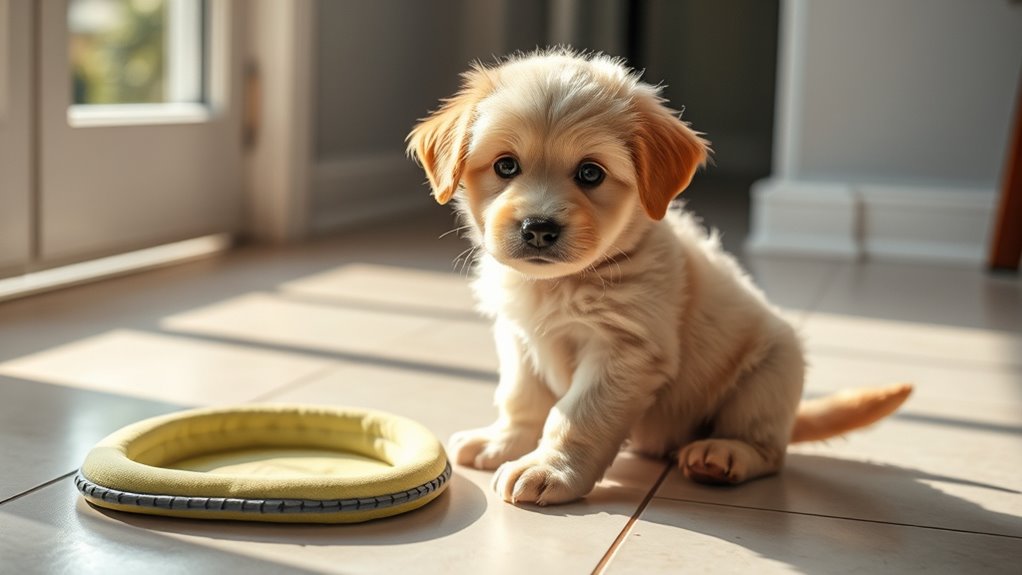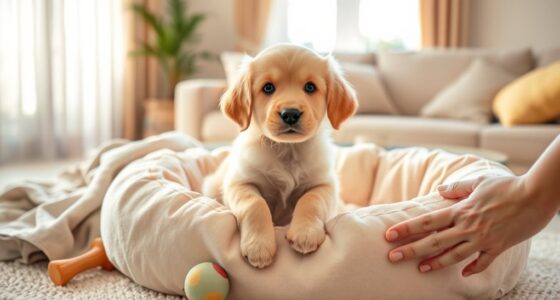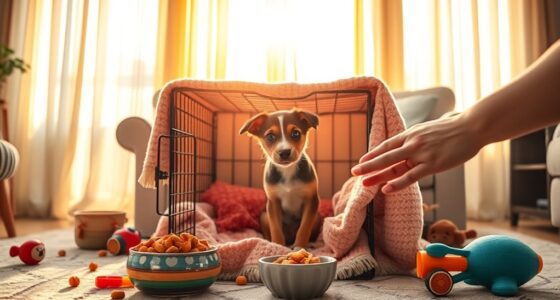To housebreak your puppy, establish a consistent routine by feeding at regular times and taking them outside to a designated potty spot frequently, especially after meals, naps, and play. Watch for signals like sniffing or circling, and reinforce good habits with praise and treats. Keep the potty area clean and use a crate for confinement to prevent accidents. With patience and persistence, your puppy will learn faster—keep going to discover more helpful tips.
Key Takeaways
- Establish a consistent routine with scheduled bathroom breaks after meals, naps, and playtime.
- Choose a designated potty area and keep it clean to encourage regular use.
- Use clear cues like “Go potty” and reward immediately to reinforce good habits.
- Stay calm and patient with accidents, cleaning them up quietly without punishment.
- Build trust through positive reinforcement, routine, and gradual socialization to support long-term success.
Understanding Your Puppy’s Bathroom Needs
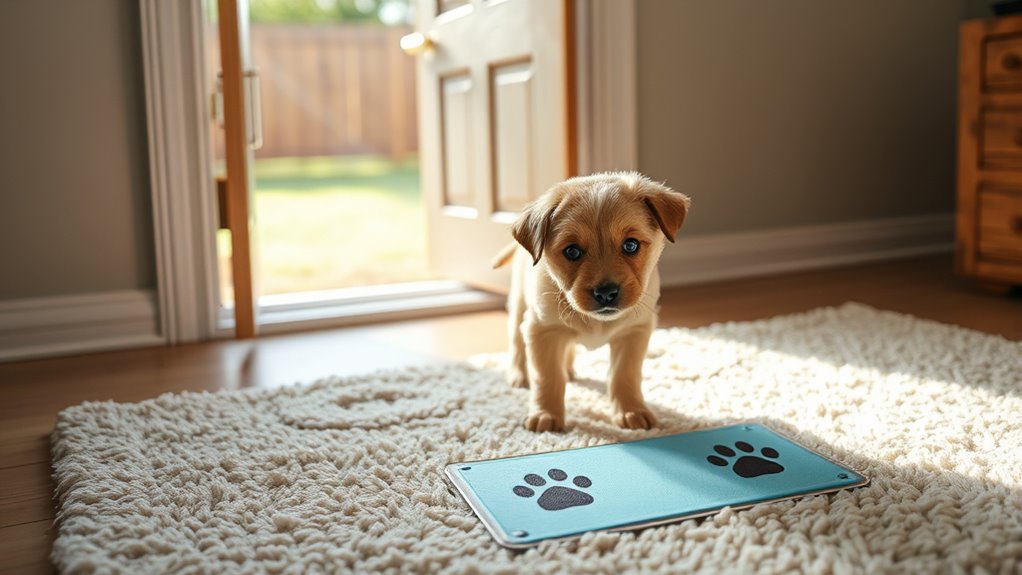
Understanding your puppy’s bathroom needs is essential for successful potty training. Puppies often sniff and engage in puppy scent marking to communicate with other dogs and establish territory, which can influence their bathroom habits. Recognizing these signals helps you identify when your puppy needs to go. Additionally, considering indoor potty options, like pee pads or artificial grass, gives your puppy a designated space, especially during bad weather or nighttime. Puppies usually have small bladders and need frequent bathroom breaks, so learning their cues is key. Being aware of color accuracy and visual cues can help you better interpret your puppy’s behavior and preferences. Monitoring your puppy’s behavioral signals and providing appropriate indoor solutions create a supportive environment that encourages good habits. Recognizing natural behaviors related to bathroom needs can further assist in understanding your puppy’s routines. Understanding water-related behaviors can further assist in recognizing when your puppy needs to go outside. Consistent routines and understanding these behaviors, along with observing environmental factors, set a solid foundation for successful housebreaking.
Setting Up a Designated Potty Area
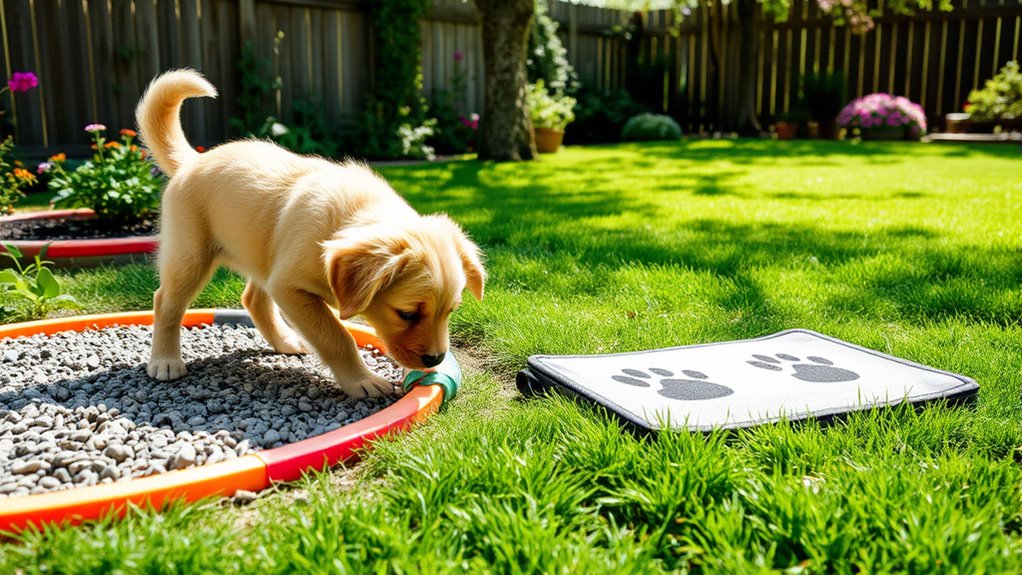
Start by choosing a safe, easily accessible spot where your puppy can go potty. Use consistent markers like a specific mat or gravel to help them recognize the area. Keep the space clean to encourage good habits and prevent odors from spreading. Additionally, consider using a designated potty area with appropriate materials to reinforce the habit and make cleanup easier. Using proper cleaning supplies can help maintain hygiene and discourage your puppy from eliminating elsewhere.
Choose a Safe Spot
Choosing the right spot for your puppy to go potty is essential for successful training. You want a safe, quiet area away from high traffic or distractions, which helps your puppy associate that spot with elimination. Keep it consistent to reinforce good habits. This spot also becomes part of your puppy’s socialization process, as they learn to feel comfortable in different environments. During grooming routines or other handling, avoid placing your puppy near their designated potty area to prevent confusion. If you have a yard, select a corner that’s far from play zones and food spots. Consistency and safety are key, so stick to this spot until your puppy reliably goes there. This helps establish clear boundaries and makes housebreaking smoother. Using names inspired by your dog’s personality can also help you communicate more effectively during training. Additionally, understanding appropriate housebreaking methods can accelerate your puppy’s learning curve and reduce accidents. Incorporating positive reinforcement techniques can further motivate your puppy to use the designated area consistently. Properly housebreaking routines are vital for establishing good habits early on.
Use Consistent Markers
Once you’ve selected a safe, quiet spot for your puppy to go potty, it’s important to establish clear, consistent markers to help your puppy recognize the designated area. Many housebreaking myths suggest using vague cues, but consistency is key. Use the same words or commands each time you take your puppy to the spot, like “Go potty.” This helps build a clear association. Relying on potty training timers can be helpful, but markers reinforce the habit. Avoid confusing your puppy with different commands or inconsistent routines. When your pup begins to go, praise them immediately with a specific marker word or phrase. Over time, your puppy will associate these cues with the behavior, making housebreaking smoother and more effective. Incorporating consistent routines into your training can further enhance your puppy’s understanding and success. Utilizing positive reinforcement techniques also encourages your puppy to repeat the desired behavior and accelerates the housebreaking process. Additionally, understanding personality traits can help tailor your training approach to better suit your puppy’s individual temperament. Recognizing housebreaking success factors can also help you troubleshoot and improve your training methods. Moreover, creating a dedicated potty area helps your puppy develop a routine and reduces accidents around your home.
Keep Area Clean
Keeping the designated potty area clean is essential for successful housebreaking. Regular household cleaning prevents odors and keeps the space inviting for your puppy. After each use, thoroughly remove waste and wash the area with safe, puppy-friendly cleaners. Maintaining good puppy hygiene helps reduce the risk of infections and discourages your puppy from seeking alternative spots. A clean potty zone also reinforces positive associations, making your puppy more likely to use it consistently. Keep the area dry and odor-free to prevent bacteria buildup. Hygienic environment promotes good habits and speeds up the training process. By staying diligent with cleaning, you create a hygienic environment that promotes good habits and speeds up the training process. Remember, a clean potty area benefits both your puppy’s health and your household’s overall cleanliness.
Establishing a Consistent Routine and Schedule
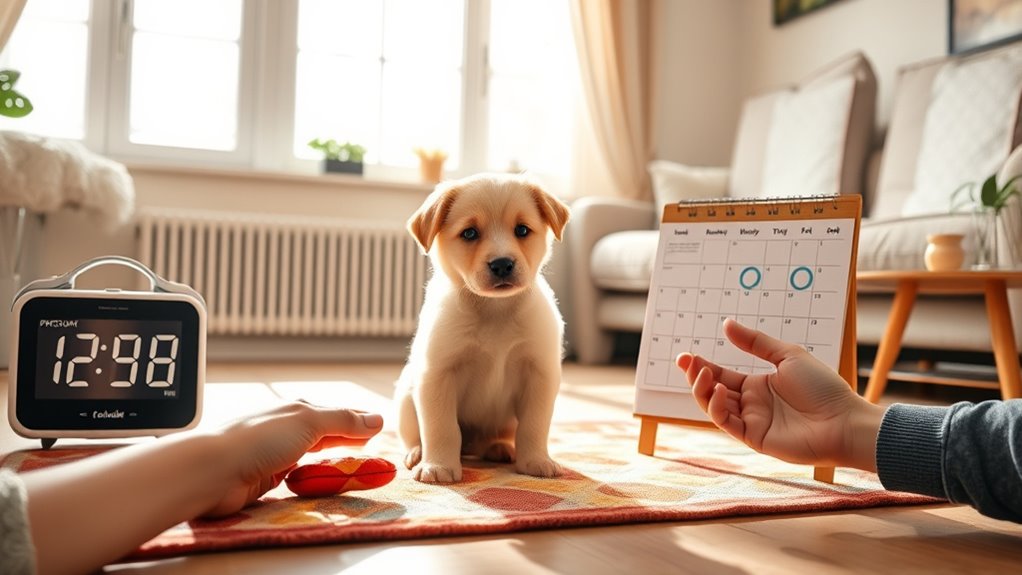
Creating a consistent routine helps your puppy understand when to go potty and reduces accidents. Stick to regular feeding times and plan bathroom breaks accordingly. This consistency makes potty training more predictable and effective for both of you. Additionally, incorporating scheduled bathroom breaks into your routine ensures your puppy has ample opportunities to relieve themselves outside. Consistent routines also help reduce confusion and build your puppy’s understanding of expectations. Establishing a housebreaking schedule can further reinforce good habits and streamline the training process. Maintaining this routine consistently can also help your puppy develop good habits that last a lifetime.
Consistent Feeding Times
Establishing consistent feeding times helps your puppy develop a predictable routine, which is essential for successful potty training. When you feed your puppy at the same times each day, it supports proper puppy nutrition and makes it easier to anticipate bathroom needs. A regular schedule helps your pup learn when to expect food and reduces accidents caused by unpredictability. Plus, consistent feeding times can improve leash training, as your puppy associates walks and bathroom breaks with specific periods. Avoid free-feeding, which can lead to confusion and irregular bathroom habits. By sticking to a set feeding routine, you’ll better understand your puppy’s bathroom signals and create a stable environment that encourages housebreaking success. Establishing healthy boundaries around feeding times can also reinforce your puppy’s understanding of routines and expectations. Maintaining a consistent schedule and using specialized feeding equipment can further support your potty training efforts, as they help regulate your puppy’s eating and bathroom habits, creating a more predictable routine for both of you. Additionally, understanding potty training basics and how tuning your training approach can lead to faster results helps ensure your puppy develops good bathroom habits early on.
Regular Bathroom Breaks
Setting a consistent schedule for bathroom breaks is key to successful puppy potty training. Regular breaks help establish good puppy hygiene and reinforce bathroom etiquette. When you stick to a routine, your puppy learns when and where to go, reducing accidents inside. Aim for bathroom breaks after meals, naps, and playtime. Consistency prevents confusion and helps your puppy develop good habits. Use the table below to plan your schedule:
| Time of Day | Bathroom Location |
|---|---|
| Morning | Backyard or designated spot |
| Midday | Same as morning |
| Evening | Same as morning |
Sticking to this routine keeps your puppy comfortable and confident, making housebreaking much smoother. Establishing a consistent routine is also essential for building trust and security with your puppy.
Recognizing Signs That Your Puppy Needs to Go
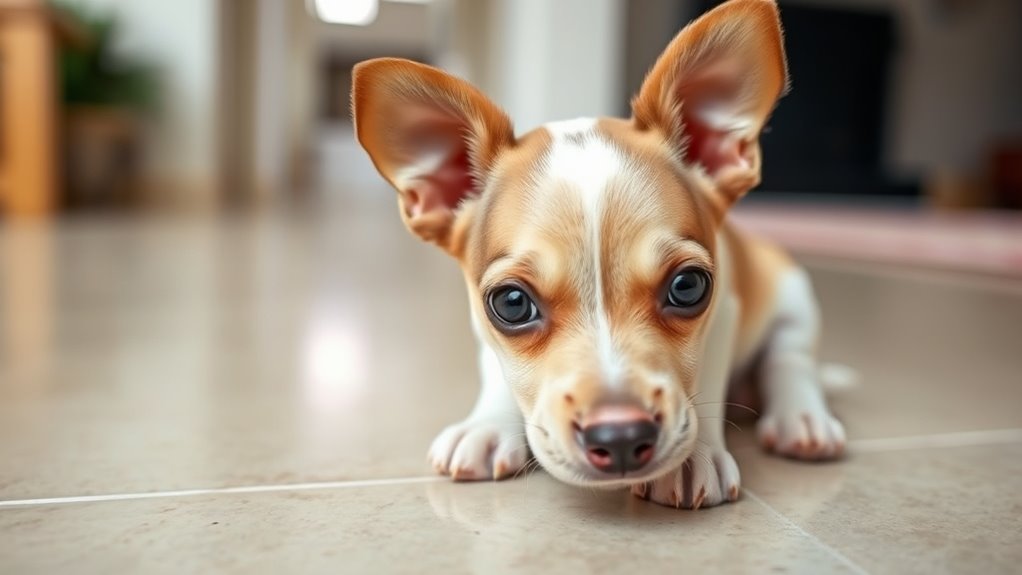
Puppies often give clear signals when they need to go outside, but recognizing these signs requires your attention. Watch for puppy signals like sniffing the floor, circling, whining, or heading toward the door. These bathroom cues indicate they need to relieve themselves soon. Your puppy might also become restless or start pacing, showing discomfort if they hold it too long. Staying alert to these behaviors helps you respond promptly and prevent accidents. Consistently observing these signs builds a communication channel between you and your puppy, making housebreaking smoother. Remember, early recognition of bathroom cues not only keeps your home clean but also teaches your puppy proper bathroom habits. Stay attentive, and your puppy will learn to signal when it’s time to go outside.
Effective Crate Training Strategies
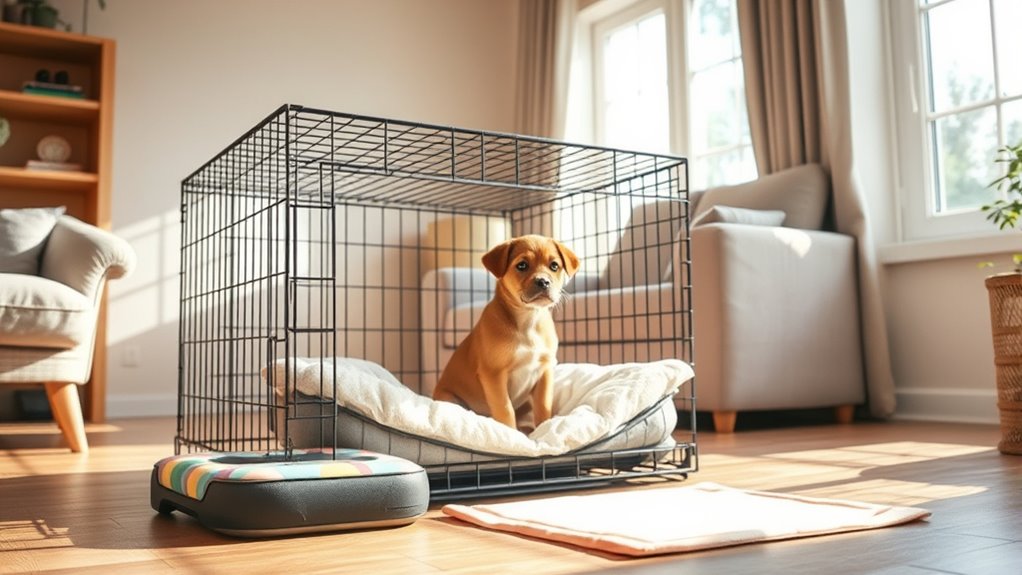
Choosing the right crate and establishing a consistent schedule are key to successful crate training. You need a crate that’s comfortable yet secure, and a routine that helps your puppy understand when to go. Let’s explore how to set up both for the best results.
Subheading 1: Choosing the Right Crate
Selecting the right crate is essential for successful potty training, as it provides your puppy with a safe and comfortable space. When choosing a crate, focus on proper crate selection to ensure it’s not too big or too small. A crate that’s too large can encourage your puppy to eliminate in one corner and sleep in another, defeating the purpose of puppy confinement. Look for a crate that allows your puppy to stand, turn around, and lie down comfortably. The ideal size promotes a sense of security and helps reinforce housebreaking habits. Remember, the goal is to create a cozy, confined space where your puppy feels safe, making crate training more effective and less stressful for both of you.
Subheading 2: Establishing Consistent Schedule
Establishing a consistent schedule is key to making crate training effective. It helps your puppy understand when to hold and when to go, breaking common housebreaking myths. Many believe puppies can hold their bladder forever, but routine is vital. Stick to regular feeding, potty, and play times, and always take your pup out immediately after waking, eating, or playing. To visualize this, consider the table:
| Time of Day | Activity |
|---|---|
| Morning | Potty break & breakfast |
| Midday | Play & potty break |
| Evening | Dinner & bedtime |
This structure minimizes accidents and builds good habits, dispelling puppy training myths that suggest inconsistent schedules are effective. Consistency helps your pup learn faster and feel secure.
Using Positive Reinforcement to Encourage Good Habits
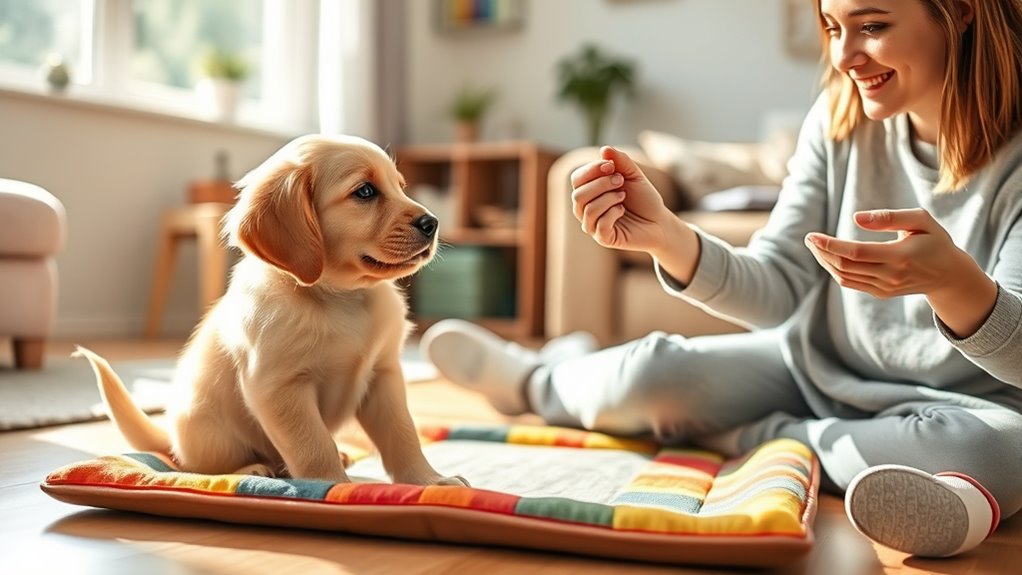
Using positive reinforcement is one of the most effective ways to encourage your puppy to develop good potty habits. When your pup goes outside or on the pad, reward them immediately with praise, treats, or play. This not only reinforces the behavior but also builds a positive association with housebreaking. To maximize success:
- Consistently reward your puppy after each successful bathroom break.
- Incorporate dog socialization by exposing them to different environments, so they’re comfortable pottying in various settings.
- Support good habits with proper puppy nutrition, ensuring your pup’s digestive health is optimized, reducing accidents.
Handling Accidents and Mistakes Calmly
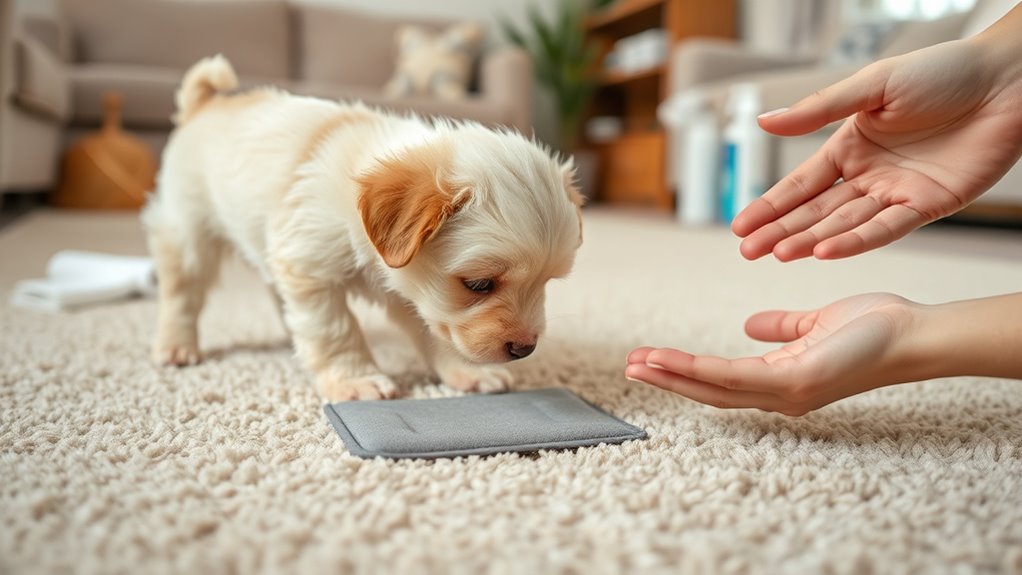
When your puppy has an accident, it’s important to stay calm and avoid punishment. Housebreaking patience is essential for effective accident management. Instead of scolding, calmly clean up the mess and reinforce your puppy’s learning by praising them when they go outside. Remember, mistakes are part of the process. Reacting with anger or harsh words can create confusion or fear, making housebreaking harder. Use a neutral tone and focus on guiding your puppy toward correct behavior. By staying patient and consistent, you help your puppy associate good habits with positive experiences. Over time, this calm approach builds trust and speeds up the learning process, leading to fewer accidents and a happier, well-trained puppy.
Gradually Increasing Outdoor Time and Independence

As your puppy becomes more comfortable with outside trips, gradually increasing their outdoor time helps build confidence and independence. This approach also enhances puppy socialization and reinforces leash training. To do this effectively, consider these steps:
- Start with short outings, allowing your puppy to explore calmly while on a leash.
- Gradually extend outdoor sessions, encouraging positive experiences and reducing anxiety.
- Incorporate socialization by introducing your puppy to new environments, sounds, and people at a comfortable pace.
Transitioning to a Full Home Without Constraints
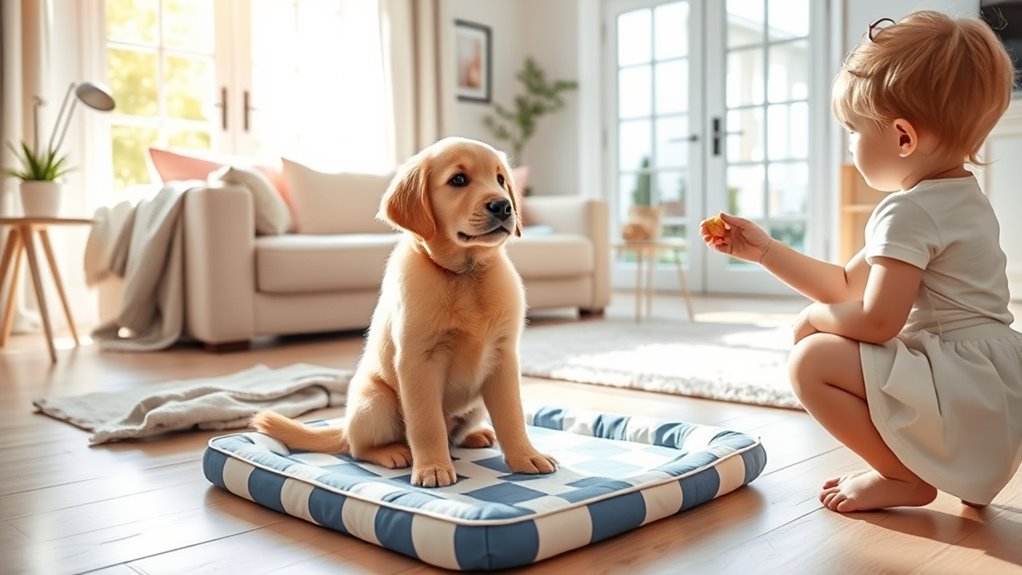
Moving your puppy to a full home without constraints marks an important step in their development. As you expand their environment, focus on consistent routines, especially around puppy nutrition, to keep them comfortable and healthy. Proper nutrition supports their growth and helps prevent accidents caused by hunger or digestive issues. During this phase, socialization techniques become vital; introduce your puppy to different rooms, people, and safe outdoor spaces gradually. This helps build their confidence and reduces fear or anxiety. Keep supervision tight and reinforce potty training habits. Remember, patience remains key. By managing their diet and social experiences thoughtfully, you set the foundation for a well-adjusted, house-trained pup ready to explore their full home safely.
Maintaining Long-Term Potty Training Success
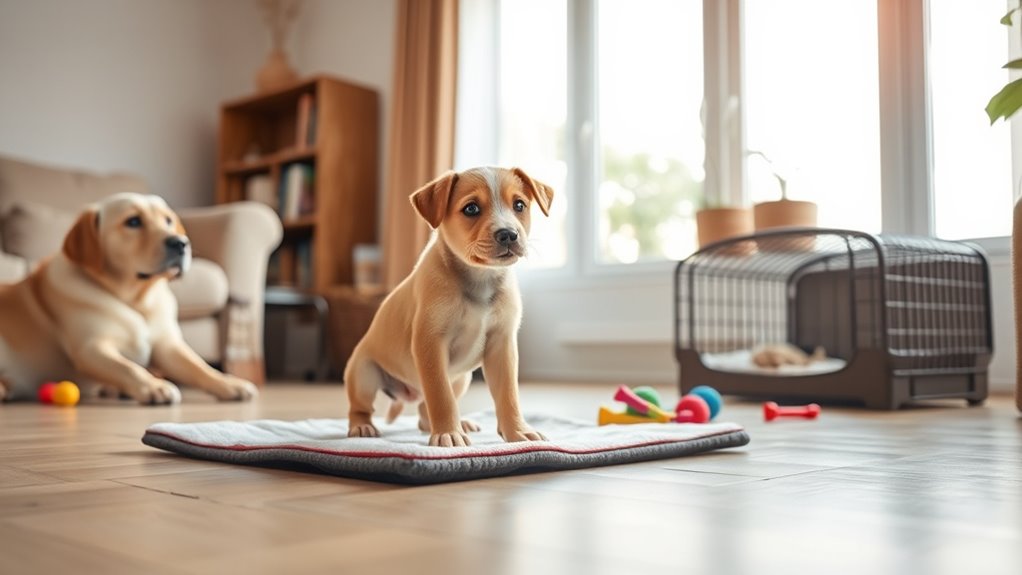
Maintaining long-term potty training success requires ongoing consistency and reinforcement. To keep your puppy on track, follow these steps:
Consistent routines and positive reinforcement ensure lasting potty training success.
- Stick to a routine, taking your puppy out at regular intervals and after grooming or playtime.
- Reinforce good habits with praise and treats, especially during socialization tips that encourage positive behavior around strangers and other animals.
- Keep training sessions short but frequent, integrating puppy grooming into your schedule to prevent accidents and build trust.
Frequently Asked Questions
How Long Does It Typically Take to Fully Housetrain a Puppy?
It typically takes anywhere from 4 to 6 months to fully housetrain your puppy. You should focus on crate training and consistency techniques, which help your puppy learn bladder control and routines. By maintaining a regular schedule, rewarding good behavior, and keeping training sessions consistent, you’ll see progress faster. Remember, patience and persistence are key, and every puppy learns at their own pace.
What Should I Do if My Puppy Refuses to Use the Potty Area?
If your puppy stubbornness leads to potty refusal, stay patient and consistent. Use potty refusal techniques like rewarding any attempt to go outside and gently encouraging them. Make sure the potty area is appealing and accessible. If they still refuse, consider their comfort or health issues. Keep a routine, avoid punishment, and praise successes. Over time, your puppy will learn to associate the right spot with positive outcomes.
How Can I Prevent My Puppy From Developing Bad Bathroom Habits?
To prevent your puppy from developing bad bathroom habits, establish a consistent schedule for potty times and reward them with positive reinforcement whenever they go outside. This approach helps your pup connect good behavior with rewards and reduces accidents. Be patient and persistent, ensuring you praise or treat immediately after successful bathroom use. Over time, this consistency builds good habits and discourages undesirable bathroom behaviors.
Are There Specific Breeds That Are Easier or Harder to Potty Train?
While some breeds are known for easier potty training, like Beagles, others like Dachshunds can present more training challenges. Breed differences influence how quickly you see progress, but your consistency and patience matter most. Instead of focusing solely on breed traits, adapt your approach to your puppy’s personality. Remember, every dog learns at their own pace, and your dedication will help overcome breed-specific hurdles, making training a success.
When Should I Start Transitioning My Puppy From Crate to Free Roam?
You should start shifting your puppy from crate training to free roam once they consistently hold their bladder for a few hours and show they can be trusted indoors. Gradually increase outdoor access, supervising closely, so they learn boundaries. Make sure they’ve developed good potty habits and are comfortable in the new environment before giving more freedom. This helps make a smooth transition while reinforcing positive behavior.
Conclusion
By following these steps, you’ll build a strong foundation for your puppy’s potty training success. Remember, patience and consistency are key—every accident is a learning opportunity. As you see progress, don’t you feel proud knowing you’re helping your puppy become confident and well-behaved? Keep celebrating small victories, stay calm, and enjoy this special bonding journey. Before long, housebreaking will feel like second nature for both of you.

